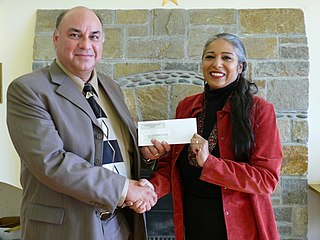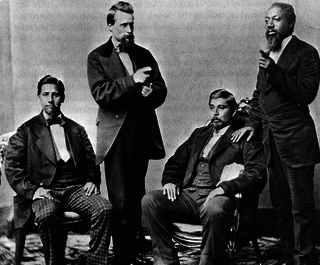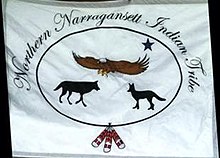
The Nooksack are a federally recognized Native American tribe near the Pacific Northwest Coast. They are a sovereign nation, located in the mainland northwest corner of Washington state in the United States along the Nooksack River near the small town of Deming, and 12 miles south of the Canadian border. As of 2008, they had more than 1,800 enrolled members. Their terms for citizenship include descent from persons listed in a 1942 tribal census.

The Wampanoag, also rendered Wôpanâak, are a Native American people of the Northeastern Woodlands based in southeastern Massachusetts and historically parts of eastern Rhode Island, Their territory included the islands of Martha's Vineyard and Nantucket.

The Narragansett people are an Algonquian American Indian tribe from Rhode Island. Today, Narragansett people are enrolled in the federally recognized Narragansett Indian Tribe. They gained federal recognition in 1983.

The Pokanoket was the village governed by Massasoit. The term broadened to refer to all peoples and lands governed by Massasoit and his successors, which were part of the Wampanoag people in what is now Rhode Island and Massachusetts.

Blood quantum laws or Indian blood laws are laws in the United States that define Native American status by fractions of Native American ancestry. These laws were enacted by the federal government and state governments as a way to establish legally defined racial population groups. By contrast, many tribes do not include blood quantum as part of their own enrollment criteria.

The Eastern Pequot Tribal Nation is an American Indian tribe in southeastern Connecticut descended from the Pequot people who dominated southeastern New England in the seventeenth century. It is one of five tribes recognized by the state of Connecticut.
The Brothertown Indians, located in Wisconsin, are a Native American tribe formed in the late 18th century from communities of so-called "praying Indians", descended from Christianized Pequot, Narragansett, Montauk, Tunxis, Niantic, and Mohegan (Algonquian-speaking) tribes of southern New England and eastern Long Island, New York. In the 1780s after the American Revolutionary War, they migrated from New England into New York state, where they accepted land from the Iroquois Oneida Nation in Oneida County.
The Redding Rancheria is a federally recognized tribe with a reservation in Shasta County, Northern California. It is a leader in the development of their people in their traditional homelands. The Bureau of Indian Affairs purchased the land that is now considered the Redding Rancheria in 1922, in order to provide Indigenous peoples with a place to camp and live. They had been made landless by European-American settlers in the area. Three groups of Native Americans in the area organized as a tribe and were recognized in 1979.
The Mohegan are an Algonquian Native American tribe historically based in present-day Connecticut. Today the majority of the people are associated with the Mohegan Indian Tribe, a federally recognized tribe living on a reservation in the eastern upper Thames River valley of south-central Connecticut. It is one of two federally recognized tribes in the state, the other being the Mashantucket Pequot, whose reservation is in Ledyard, Connecticut. There are also three state-recognized tribes: the Schaghticoke, Paugusett, and Eastern Pequot.
The Cherokee Freedmen controversy was a political and tribal dispute between the Cherokee Nation of Oklahoma and descendants of the Cherokee Freedmen regarding the issue of tribal membership. The controversy had resulted in several legal proceedings between the two parties from the late 20th century to August 2017.

American Indian tribal recognition in the United States most often refers to the process of a tribe being recognized by the United States federal government, or to a person being granted membership to a federally recognized tribe. There are 574 federally recognized tribal governments in the United States. Non-Acknowledged Tribes are tribes which have no federal designation as sovereign entities. This is not to be confused with recognition of Native Americans in the US which are defined by the BIA as any descendant of the Indigenous peoples of the Americas which is a US citizen. Federally Non-Recognized tribes refers to a subgroup of non-acknowledged tribes which had some sort of recognition by the British prior to the formation of the United States or by the United States but which were determined by the government to no longer exist as an Indian tribe or no longer meet the criteria for a nation to nation status.

Fort Ninigret is a historic fort and trading post site at Fort Neck Road in Charlestown, Rhode Island, built and occupied by European settlers in the seventeenth century. At its 1883 dedication, Commissioner George Carmichael, Jr. referred to it as "the oldest military post on the Atlantic coast."

The Seminole Nation of Oklahoma is a federally recognized Native American tribe based in the U.S. state of Oklahoma. It is the largest of the three federally recognized Seminole governments, which include the Seminole Tribe of Florida and the Miccosukee Tribe of Indians of Florida. Its members are descendants of the 3,000 Seminoles who were forcibly removed from Florida to Indian Territory, along with 800 Black Seminoles, after the Second Seminole War. The Seminole Nation of Oklahoma is headquartered in Wewoka within Seminole County, Oklahoma. Of 18,800 enrolled tribal members, 13,533 live in Oklahoma. The tribe began to revive its government in 1936 under the Indian Reorganization Act. While its reservation was originally larger, today the tribal jurisdictional area covers Seminole County, Oklahoma, within which it has a variety of properties.

Native American tribes in Massachusetts are the Native American tribes and their reservations that existed historically and those that still exist today in what is now the Commonwealth of Massachusetts. A Narragansett term for this region is Ninnimissinuok.
Carcieri v. Salazar, 555 U.S. 379 (2009), was a case in which the Supreme Court of the United States held that the federal government could not take land into trust that was acquired by the Narragansett Tribe in the late 20th century, as it was not federally recognized until 1983. While well documented in historic records and surviving as a community, the tribe was largely dispossessed of its lands while under guardianship by the state of Rhode Island before suing in the 20th century.

The Narragansett land claim was one of the first litigations of aboriginal title in the United States in the wake of the U.S. Supreme Court's landmark Oneida Indian Nation of New York v. County of Oneida (1974), or Oneida I, decision. The Narragansett claimed a few thousand acres of land in and around Charlestown, Rhode Island, challenging a variety of early 19th century land transfers as violations of the Nonintercourse Act, suing both the state and private land owners.
The Pechanga Band of Indians is a federally recognized tribe of Luiseño Indians based in Riverside County, California, where their reservation is located. As of 2006, there were 1,370 members of the nation. The tribe owns the Pechanga Resort & Casino in Temecula and the naming rights to the San Diego sports arena now known as the Pechanga Arena.

Paulla Dove Jennings is a Narragansett storyteller, educator, and children's book author.

The Miami Nation of Indiana is a group of individuals who identify as Miami and have organized as a 501(c)(3) nonprofit organization. The group's headquarters are at Peru, Indiana.
In the United States, tribal disenrollment is a process by which a Native American individual loses citizenship or the right to belong within a Native American tribe.











